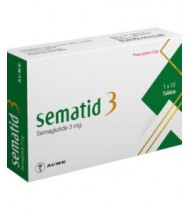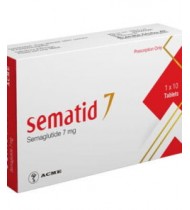Semaglutide (Tablet)
Indications
Semaglutide is a glucagon-like peptide-1 (GLP-1) receptor agonist indicated as an adjunct to diet and exercise to improve glycemic control in adults with type 2 diabetes mellitus
Pharmacology
Semaglutide is a GLP-1 analogue with 94% sequence homology to human GLP-1. Semaglutide acts as a GLP-1 receptor agonist that selectively binds to and activates the GLP-1 receptor, the target for native GLP-1. GLP-1 is a physiological hormone that has multiple actions on glucose, mediated by the GLP-1 receptors. The principal mechanism of protraction resulting in the long half-life of semaglutide is albumin binding, which results in decreased renal clearance and protection from metabolic degradation. Furthermore, semaglutide is stabilized against degradation by the DPP-4 enzyme. Semaglutide reduces blood glucose through a mechanism where it stimulates insulin secretion and lowers glucagon secretion, both in a glucose-dependent manner. Thus, when blood glucose is high, insulin secretion is stimulated and glucagon secretion is inhibited. The mechanism of blood glucose lowering also involves a minor delay in gastric emptying in the early postprandial phase.
Dosage & Administration
Instruct patients to take Semaglutide at least 30 minutes before the first food, beverage, or other oral medications of the day with no more than 4 ounces of plain water only. Waiting less than 30 minutes, or taking with food, beverages (other than plain water) or other oral medications will lessen the effect of Semaglutide. Waiting more than 30 minutes to eat may increase the absorption of Semaglutide.
Swallow tablets whole. Do not cut, crush, or chew tablets. Start Semaglutide with 3 mg once daily for 30 days. After 30 days on the 3 mg dose, increase the dose to 7 mg once daily. Dose may be increased to 14 mg once daily if additional glycemic control is needed after at least 30 days on the 7 mg dose.
Swallow tablets whole. Do not cut, crush, or chew tablets. Start Semaglutide with 3 mg once daily for 30 days. After 30 days on the 3 mg dose, increase the dose to 7 mg once daily. Dose may be increased to 14 mg once daily if additional glycemic control is needed after at least 30 days on the 7 mg dose.
Interaction
Oral Medications: Semaglutide delays gastric emptying. When coadministering oral medications instruct patients to closely follow semaglutide administration instructions. Consider increased clinical or laboratory monitoring for medications that have a narrow therapeutic index or that require clinical monitoring.
Contraindications
Personal or family history of medullary thyroid carcinoma or in patients with Multiple Endocrine Neoplasia syndrome type 2. Known hypersensitivity to semaglutide or any of the components in this preparation.
Side Effects
The most common adverse reactions, reported in ≥5% of patients treated with Semaglutide are: nausea, abdominal pain, diarrhea, decreased appetite, vomiting and constipation.
Pregnancy & Lactation
Pregnancy: May cause fetal harm.
Lactation: Breastfeeding not recommended.
Females and Males of Reproductive Potential: Discontinue Semaglutide in women at least 2 months before a planned pregnancy due to the long washout period for semaglutide.
Lactation: Breastfeeding not recommended.
Females and Males of Reproductive Potential: Discontinue Semaglutide in women at least 2 months before a planned pregnancy due to the long washout period for semaglutide.
Precautions & Warnings
Pancreatitis: Has been reported in clinical trials. Discontinue promptly if pancreatitis is suspected. Do not restart if pancreatitis is confirmed.
Diabetic Retinopathy Complications: Has been reported in a cardiovascular outcomes trial with semaglutide injection. Patients with a history of diabetic retinopathy should be monitored.
Hypoglycemia: When semaglutide is used with an insulin secretagogue or insulin, consider lowering the dose of the secretagogue or insulin to reduce the risk of hypoglycemia.
Acute Kidney Injury: Monitor renal function in patients with renal impairment reporting severe adverse gastrointestinal reactions.
Hypersensitivity Reactions: Discontinue semaglutide if suspected and promptly seek medical advice.
Diabetic Retinopathy Complications: Has been reported in a cardiovascular outcomes trial with semaglutide injection. Patients with a history of diabetic retinopathy should be monitored.
Hypoglycemia: When semaglutide is used with an insulin secretagogue or insulin, consider lowering the dose of the secretagogue or insulin to reduce the risk of hypoglycemia.
Acute Kidney Injury: Monitor renal function in patients with renal impairment reporting severe adverse gastrointestinal reactions.
Hypersensitivity Reactions: Discontinue semaglutide if suspected and promptly seek medical advice.
Use in Special Populations
Pediatric Use: Safety and efficacy of Semaglutide have not been established in pediatric patients (younger than 18 years).
Geriatric Use: No overall differences in safety or efficacy were detected between these patients and younger patients, but greater sensitivity of some older individuals cannot be ruled out.
Renal Impairment: The safety and efficacy of Semaglutide was evaluated in a 26-week clinical study that included 324 patients with moderate renal impairment (eGFR 30 to 59 mL/min/1.73 m2). In patients with renal impairment including end-stage renal disease (ESRD), no clinically relevant change in semaglutide pharmacokinetics (PK) was observed. No dose adjustment of Semaglutide is recommended for patients with renal impairment.
Hepatic Impairment: In a study in subjects with different degrees of hepatic impairment, no clinically relevant change in semaglutide pharmacokinetics (PK) was observed. No dose adjustment of Semaglutide is recommended for patients with hepatic impairment.
Geriatric Use: No overall differences in safety or efficacy were detected between these patients and younger patients, but greater sensitivity of some older individuals cannot be ruled out.
Renal Impairment: The safety and efficacy of Semaglutide was evaluated in a 26-week clinical study that included 324 patients with moderate renal impairment (eGFR 30 to 59 mL/min/1.73 m2). In patients with renal impairment including end-stage renal disease (ESRD), no clinically relevant change in semaglutide pharmacokinetics (PK) was observed. No dose adjustment of Semaglutide is recommended for patients with renal impairment.
Hepatic Impairment: In a study in subjects with different degrees of hepatic impairment, no clinically relevant change in semaglutide pharmacokinetics (PK) was observed. No dose adjustment of Semaglutide is recommended for patients with hepatic impairment.
Overdose Effects
In the event of overdose, appropriate supportive treatment should be initiated according to the patient’s clinical signs and symptoms. A prolonged period of observation and treatment for these symptoms may be necessary, taking into account the long half-life of Semaglutide of approximately 1 week.
Therapeutic Class
GLP-1 receptor agonists
Storage Conditions
Keep below 30°C temperature, away from light & moisture. Keep out of the reach of children.
Sematid Tablet 3mg
IndicationsSemaglutide is a glucagon-like peptide-1 (GLP-1) receptor agonist indicated as an adjunct..
800.00Tk.
Sematid Tablet 7mg
IndicationsSemaglutide is a glucagon-like peptide-1 (GLP-1) receptor agonist indicated as an adjunct..
1,800.00Tk.
Showing 1 to 2 of 2 (1 Pages)


